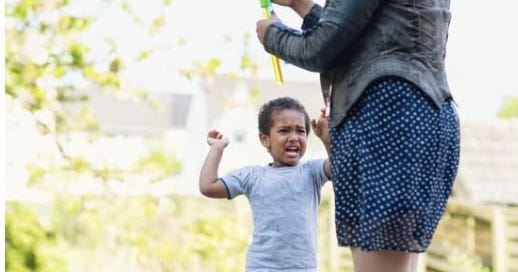He’s Crying Again—And You’re Wondering If Gentle Parenting Works
What Your Child Really Needs When They Cry: How to Set Limits and Still Validate Feelings (Toddler to Tween)
He’s crying again.
This time, it’s not the broken cracker—it’s because his favorite dump truck shirt is in the wash.
He’s only three, but still—this feels like too much.
"It’s not a big deal. Why are we doing this again?"
That familiar voice creeps in: “Maybe my mom is right. Maybe all this validating is making him soft.”
This is where so many parents start to second-guess themselves. They worry that empathizing will make their child whiny, overly sensitive, or unable to handle disappointment.
But here’s the truth:
Telling your child, “It’s not a big deal,” doesn’t build resilience. It tells them you don’t understand. And it often leads to louder tears—because now they’re not just upset about the shirt. They’re trying to show you that it is a big deal to them.
As both a parent and an early childhood educator, I want to be clear: It’s not your job to stop your child from crying. Children who feel heard and understood actually cry less, not more. When you validate their emotions, you’re not coddling them—you’re teaching them that feelings are manageable. This is what builds emotional regulation over time.
Validation doesn’t mean you agree. It doesn’t mean you give in. It simply means: “You’re really upset about this. I can see that.” Now, they don’t have to cry louder to be taken seriously.
The rise of gentle parenting has left many parents confused. On one side, they've recognized the harm in dismissing children's emotions, but on the other, they mistake that validation means surrendering all boundaries and structure. Acknowledging feelings DOES NOT mean giving in to demands. Setting limits DOES NOT MEAN being harsh. Children need to know their emotions are acceptable while also learning that certain behaviors are not.
Understanding this distinction is crucial: we can fully validate feelings ("You're really angry right now") while still maintaining necessary boundaries ("And hitting isn't okay, even when you're angry").
So what does this actually look like in real life—when you’ve got a screaming toddler or a sulking 9-year-old? Let’s break it down. Here’s how validation can sound and feel at different ages—so you’re not just guessing in the heat of the moment…
What Validation Looks Like at Every Age (From Toddlers to Tweens)
So you’re not just guessing in the heat of the moment
(The rest of this piece is for paid subscribers—inside, you'll find age-by-age examples of what validation really sounds like (from toddlers to tweens), real-life scripts for tough moments, and a printable you can keep handy for when emotions run high.)
Keep reading with a 7-day free trial
Subscribe to The Workspace for Children to keep reading this post and get 7 days of free access to the full post archives.





